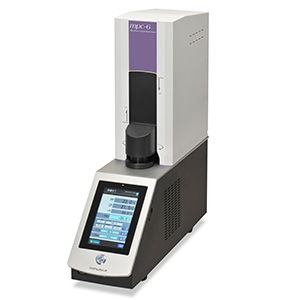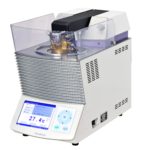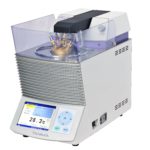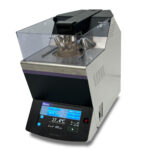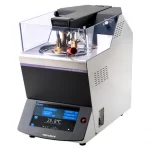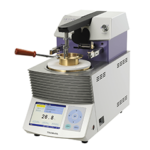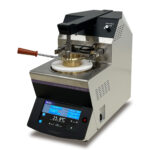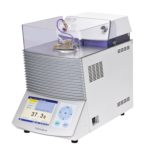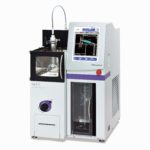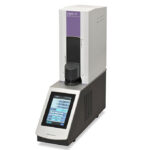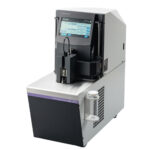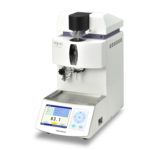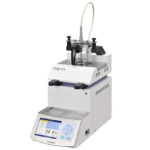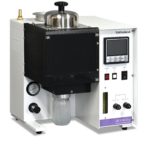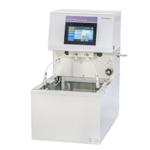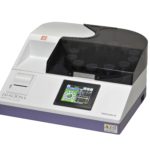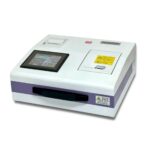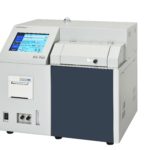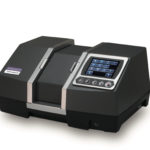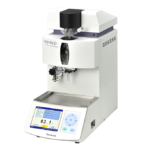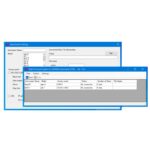Proprietary technology "Air Pressure Method"
Proprietary technology "Air Pressure Method"detects a slight movement of specimen surface caused by applying a weak static air pressure, which gives a minimum disturbance to the formation of wax crystal network or increased viscosity. Now, PP can be controlled at a narrower control window. (The automated tilting apparatus as well as the original manual tilting apparatus have been known to give excessive and/or unpredictable amount of disturbance, which contributed to the poor precision in the past.)
The pour point test method that our MPC series pour/cloud point testers utilize has been finally approved by ASTM. The ASTM number is D6749.
( http://www.astm.org/Standards/D6749.htm )
After that, the cloud point method has been adopted by ASTM International as ASTM D7683.
Advantages of ”Air Pressure Method"
PP with higher precision at 1 degree intervals
Evaluation made by our users proved superior precision for Pour Point (PP) determination.
| Repeatability | 1 degree (when PP is tested at 1 degree intervals) |
|---|---|
| Reproducibility | 2 degrees (when PP is tested at 1 degree intervals) |
This high precision was achieved by adopting "Air Pressure Method".
Consecutive Cloud Point-Pour Point determination
When both PP and CP are called, while on a typical automatic tilting apparatus CP and PP need to be determined by separate test heads, Tanaka MPC series determines CP and then PP in one test cycle and in one test head.
This doubles the productivity of the apparatus. (With the rapid cooling which already cuts the PP test in half, when both CP and PP need to be determined, the overall test throughput is 4 times that of a conventional automatic tilting apparatus.)
Only 4.5 mL sample volume
The mpc-6 required mere 4.5 mL sample and provides quick automatic determination of Pour / Cloud Point with high precision.
Higher Test Throughput
While improving the precision, steepest cooling rate possible was sought.
Time needed for a typical PP(and/or CP) determination has been cut in half or less.
| Sample Type | Pour Point | Test Time (*1) | Test Time by MPC |
|---|---|---|---|
| Diesel Fuel Oils | -10 degrees | 80 min | 30 min |
| Diesel Fuel Oils | -32.5 degrees | 140 min | 45 min |
| Light Fuel Oils | -12.5 degrees | 140 min | 30 min |
| Light Fuel Oils | -27.5 degrees | 80 min | 35 min |
| Heavy Fuel Oils | -10 degrees | 90 min | 55 min |
| Heavy Fuel Oils (*2) | -20 degrees | 115 min | 60 min |
*1
Equivalent to ASTM D5950 test method by an automatic tilting apparatus
*2
Heavy fuel oil samples have been pre-heated at 45 degrees prior to testing, which stretched the testing time.
(Above data has been taken by a refinery laboratory in Japan.
Note that under the current Japanese Industrial Standard for PP determination, PP is determined at a 2.5 degrees interval, which is the reason the PPs in the above table are in the multiple of 2.5 degrees.)
MPC series with "Air Pressure Method" (Current model : mpc-6)
Ever since its debut, MPC series Pour/Cloud Point Testers have proven its advantages in various spectrum and at a number of occasions.


